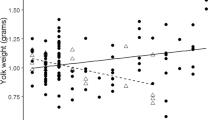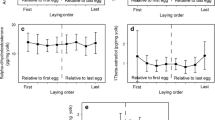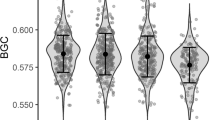Abstract
Maternally derived androgen hormones concentrate in avian egg yolks as the yolks grow on the female’s ovary, possibly forming a basis for important maternal effects in birds. In the American kestrel (Falco sparverius), experimental elevation of yolk androgens in the first-laid egg of a clutch (a-egg) to the concentrations found naturally in a clutch’s later-laid eggs reduces the growth rate of a-egg nestlings compared to controls. These findings, together with discoveries from other species that the effects of yolk androgens on growth of female nestlings may differ from their effects on growth of male nestlings, raise the hypothesis that natural changes in yolk-androgen concentrations with laying order are ultimately due to a difference between the sexes in their yolk-androgen sensitivity and between early- and late-laid eggs in their sex ratio. By re-analyzing previously published data and adding to the analysis data from previously unanalyzed blood samples used for sex determination, we investigated possible sex-specific effects of yolk-androgens in the context of a potential sex-biased laying order in free-living American kestrels. We used a multi-level, mixed model with a Gompertz function to analyze growth of nestlings hatching from a-eggs that were control-treated or in which we experimentally elevated yolk-androgen concentrations shortly after laying to the higher concentrations naturally found in later-laid eggs. We discovered that male nestlings were more susceptible than female nestlings to growth inhibition by yolk-androgen elevation but did not find a bias in sex ratio with respect to laying order. Together, these findings do not support the above hypothesis. However, they are consistent with the hypothesis that sex differences in yolk-androgen sensitivity enable mothers to economically tune reproductive effort to an individual offspring’s reproductive value, which can vary more for one sex than the other.



Similar content being viewed by others
References
Aggrey SE (2002) Comparison of three nonlinear and spline regression models for describing chicken growth curves. Poultry Sci 81:1782–1788
Anderson DJ, Reeve J, Gomez JEM, Weathers WW, Hutson S, Cunningham HV, Bird DM (1993) Sexual size dimorphism and food requirements of nestling birds. Can J Zool 71:2541–2545
Badyaev AV, Hill GE, Beck ML, Dervan AA, Duckworth RA, McGraw KJ, Nolan PM, Whittingham LA (2002a) Sex-biased hatching order and adaptive population divergence in a passerine bird. Science 295:316–318
Badyaev AV, Hill GE, Whittingham LA (2002b) Population consequences of maternal effects: sex-bias in egg-laying order facilitates divergence in sexual dimorphism between bird populations. J Evol Biol 15:997–1003
Balgooyen TG (1976) Behavior and ecology of the American kestrel (Falco sparverius L.) in the Sierra Nevada of California. Univ Calif Publ Zool 103:1–87
Ball GF, Riters LV, Balthazart J (2002) Neuroendocrinology of song behavior and avian brain plasticity: multiple sites of action of sex steroid hormones. Front Neuroendocrin 23:137–178
Balthazart J, Absil P, Foidart A, Houbart M, Harada N, Ball GF (1996) Distribution of aromatase-immunoreactive cells in the forebrain of zebra finches (Taeniopygia guttata): implications for the neural action of steroids and nuclear definition in the avian hypothalamus. J Neurobiol 31:129–148
Bernardo J (1996) Maternal effects in animal ecology. Am Zool 36:83–105
Bird DM (1988) American kestrel. In: Palmer RS (ed) Handbook of North American birds, vol 5. Yale University Press, New Haven, Connecticut, pp 253–290
Burnham HP, Anderson DR (2002) Model selection and multimodel inference. Springer, Berlin Heidelberg New York
Clutton-Brock TH (1986) Sex ratio variation in birds. Ibis 128:317–329
Cox RM, John-Alder HB (2005) Testosterone has opposite effects on male growth in lizards (Sceloporus spp.) with opposite patterns of sexual size dimorphism. J Exper Biol 208:4679–4687
Crews D, Diamond MA, Whittier J, Mason R (1985) Small male body size in garter snake depends on testes. Am J Physiol Regul Integr Comp Physiol 249:62–66
de Freitas AR (2005) Growth curves in animal production. Braz J Anim Sci 34:786–795
Eising CM, Eikenaar C, Schwabl H, Groothuis TGG (2001) Maternal androgens in black-headed gull (Larus ridibundus) eggs: consequences for chick development. Proc R Soc Lond B 268:839–846
Godsave SF, Lohmann R, Vloet RPM, Gahr M (2002) Androgen receptors in the embryonic zebra finch hindbrain suggest a function for maternal androgens in perihatching survival. J Comp Neurol 453:57–70
Herbst KL, Bhasin S (2004) Testosterone action on skeletal muscle. Curr Opin Clin Nutr Metab Care 7:271–277
Kahn NW, St. John J, Quinn TW (1998) Chromosome-specific intron size differences in the avian CHD gene provide an efficient method for sex identification in birds. Auk 115:1074–1078
Krackow S, Tkadlec E (2001) Analysis of brood sex ratios: implications of offspring clustering. Behav Ecol Sociobiol 50:293–301
Müller W, Groothuis TGG, Eising CM, Dijkstra C (2005) An experimental study on the causes of sex-biased mortality in the black-headed gull—the possible role of testosterone. J Anim Ecol 74:735–741
Nahashon SN, Aggrey SE, Adefope NA, Amenyenu A, Wright D (2006) Growth characteristics of pearl gray Guinea fowl as predicted by the Richards, Gompertz, and logistic models. Poultry Sci 85:359–363
Pilz KM, Smith HG, Sandell MI, Schwabl H (2003) Interfemale variation in egg yolk androgen allocation in the European starling: do high-quality females invest more? Anim Behav 65:841–850
Pinheiro JC, Bates DM (2000) Mixed-effects models in S and S-PLUS. Springer, Berlin Heidelberg New York
R Development Core Team (2004) R: a language and environment for statistical computing. R Foundation for Statistical Computing, Vienna
Ricklefs RE (1968) Patterns of growth in birds. Ibis 110:419–451
Ricklefs RE (1973) Patterns of growth in birds. II. Growth rate and mode of development. Ibis 115:177–205
Royle NJ, Surai PF, Hartley IR (2001) Maternally derived androgens and antioxidants in bird eggs: complementary but opposing effects? Behav Ecol 12:381–385
Rubolini D, Romano M, Martinelli R, Saino N (2006) Effects of elevated yolk testosterone levels on survival, growth and immunity of male and female yellow-legged gull chicks. Behav Ecol Sociobiol 59:344–352
Saino N, Bertacche V, Ferrari RP, Martinelli R, Møller AP, Stradi R (2002) Carotenoid concentration in barn swallow eggs is influenced by laying order, maternal infection and paternal ornamentation. Proc R Soc Lond B 269:1729–1733
Saino N, Ferrari RP, Romano M, Martinelli R, Lacroix A, Gil D, Møller AP (2006) Maternal allocation of androgens and antagonistic effects of yolk androgens on sons and daughters. Behav Ecol 17:172–181
SAS Institute Inc (2004) SAS/STAT User’s Guide, Version 9.1. SAS Institute, Carey, North Carolina
Schwabl H (1993) Yolk is a source of maternal testosterone for developing birds. Proc Natl Acad Sci USA 90:11446–11450
Schwabl H (1996) Maternal testosterone in the avian egg enhances postnatal growth. Comp Biochem Phys A 114:271–276
Schwabl H, Mock DW, Gieg JA (1997) A hormonal mechanism for parental favouritism. Nature 386:231
Sengül T, Kiraz S (2005) Non-linear models for growth curves in large white turkeys. Turk J Vet Anim Sci 29:331–337
Smallwood PD, Smallwood JA (1998) Seasonal shifts in sex ratios of fledgling American kestrels (Falco sparverius paulus): the early bird hypothesis. Evol Ecol 12:839–853
Sockman KW, Schwabl H (1998) Hypothermic tolerance in an embryonic American kestrel (Falco sparverius). Can J Zool 76:1399–1402
Sockman KW, Schwabl H (2000) Yolk androgens reduce offspring survival. Proc R Soc Lond B 267:1451–1456
Sockman KW, Schwabl H (2001a) Covariation of clutch size, laying date, and incubation tendency in the American kestrel. Condor 103:570–578
Sockman KW, Schwabl H (2001b) Plasma corticosterone in nestling American kestrels: effects of age, handling stress, yolk androgens, and body condition. Gen Comp Endocrinol 122:205–212
Sockman KW, Schwabl H, Sharp PJ (2001) Regulation of yolk-androgen concentrations by plasma prolactin in the American kestrel. Horm Behav 40:462–471
Sockman KW, Sharp PJ, Schwabl H (2006) Orchestration of avian reproductive effort: an integration of the ultimate and proximate bases for flexibility in clutch size, incubation behaviour, and yolk-androgen deposition. Biol Rev 81:629–666
Trivers RL, Willard DE (1973) Natural selection of parental ability to vary the sex ratio of offspring. Science 179:90–92
Tschirren B, Richner H, Schwabl H (2004) Ectoparasite-modulated deposition of maternal androgens in great tit eggs. Proc R Soc Lond B 271:1371–1375
von Engelhardt N, Carere C, Dijkstra C, Groothuis TGG (2006) Sex-specific effects of yolk testosterone on survival, begging and growth of zebra finches. Proc R Soc Lond B 273:65–70
Wang Z, Zuidhof MJ (2004) Estimation of growth parameters using a nonlinear mixed Gompertz model. Poultry Sci 83:847–852
Westneat DF (1990) Genetic parentage in the indigo bunting: a study using DNA fingerprinting. Behav Ecol Sociobiol 27:67–76
Williamson KA, Surai PF, Graves JA (2006) Yolk antioxidants and mate attractiveness in the zebra finch. Funct Ecol 20:354–359
Acknowledgements
We thank Wendy Lammers for assistance in data collection and NIMH (R01 49877 to H.S.), SICB (Grant-in-Aid of Research to K.W.S.), and the WSU Department of Zoology (James R. King Fellowship to K.W.S.) for financial support. This study complies with the current laws of the USA, where it was performed.
Author information
Authors and Affiliations
Corresponding author
Additional information
Communicated by J. Graves
Rights and permissions
About this article
Cite this article
Sockman, K.W., Weiss, J., Webster, M.S. et al. Sex-specific effects of yolk-androgens on growth of nestling American kestrels. Behav Ecol Sociobiol 62, 617–625 (2008). https://doi.org/10.1007/s00265-007-0486-z
Received:
Revised:
Accepted:
Published:
Issue Date:
DOI: https://doi.org/10.1007/s00265-007-0486-z




